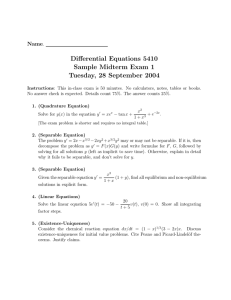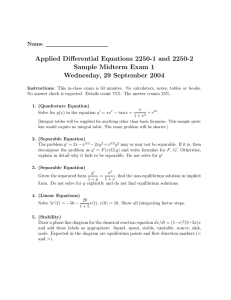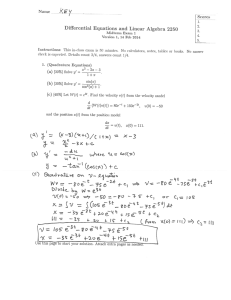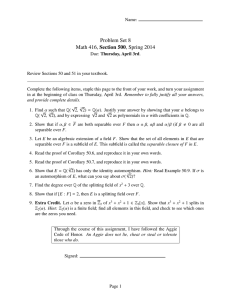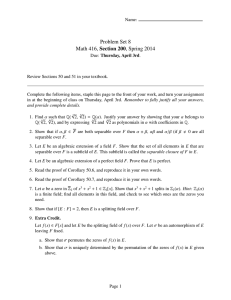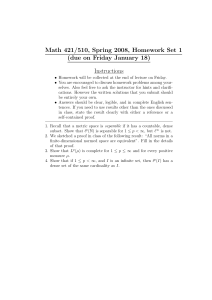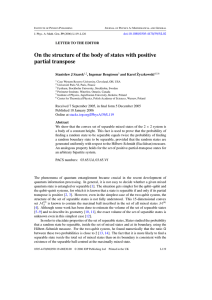On the structure of the body of states , Ingemar Bengtsson
advertisement
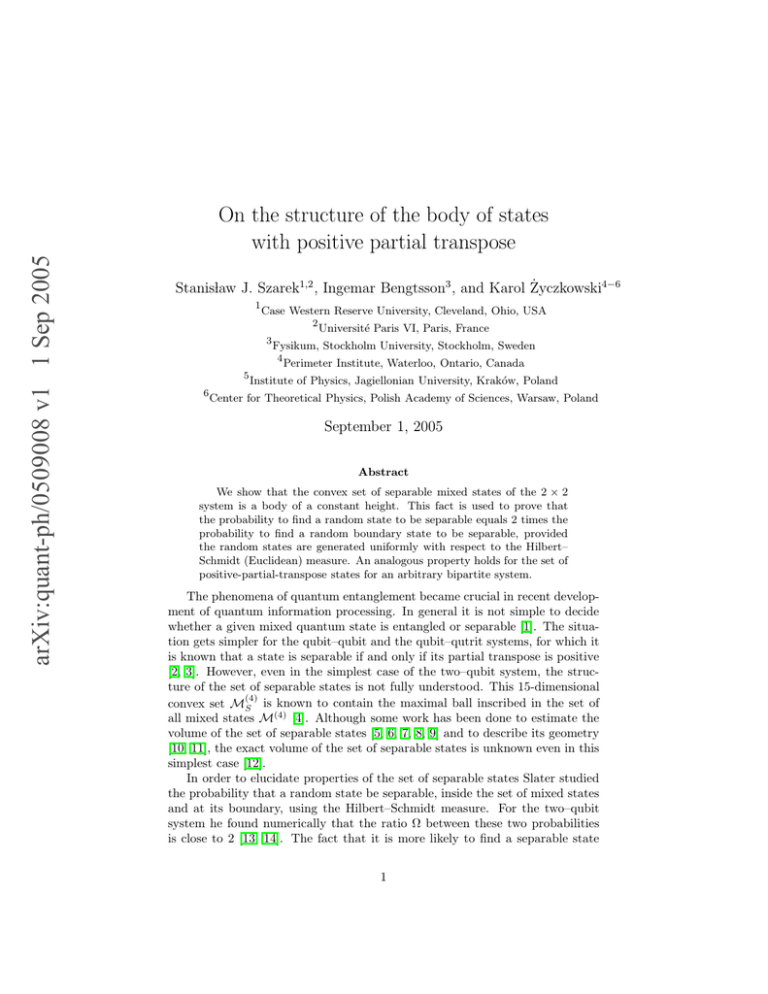
arXiv:quant-ph/0509008 v1 1 Sep 2005
On the structure of the body of states
with positive partial transpose
Stanislaw J. Szarek1,2 , Ingemar Bengtsson3 , and Karol Życzkowski4−6
1
Case Western Reserve University, Cleveland, Ohio, USA
2
3
4
5
6
Université Paris VI, Paris, France
Fysikum, Stockholm University, Stockholm, Sweden
Perimeter Institute, Waterloo, Ontario, Canada
Institute of Physics, Jagiellonian University, Kraków, Poland
Center for Theoretical Physics, Polish Academy of Sciences, Warsaw, Poland
September 1, 2005
Abstract
We show that the convex set of separable mixed states of the 2 × 2
system is a body of a constant height. This fact is used to prove that
the probability to find a random state to be separable equals 2 times the
probability to find a random boundary state to be separable, provided
the random states are generated uniformly with respect to the Hilbert–
Schmidt (Euclidean) measure. An analogous property holds for the set of
positive-partial-transpose states for an arbitrary bipartite system.
The phenomena of quantum entanglement became crucial in recent development of quantum information processing. In general it is not simple to decide
whether a given mixed quantum state is entangled or separable [1]. The situation gets simpler for the qubit–qubit and the qubit–qutrit systems, for which it
is known that a state is separable if and only if its partial transpose is positive
[2, 3]. However, even in the simplest case of the two–qubit system, the structure of the set of separable states is not fully understood. This 15-dimensional
(4)
convex set MS is known to contain the maximal ball inscribed in the set of
all mixed states M(4) [4]. Although some work has been done to estimate the
volume of the set of separable states [5, 6, 7, 8, 9] and to describe its geometry
[10, 11], the exact volume of the set of separable states is unknown even in this
simplest case [12].
In order to elucidate properties of the set of separable states Slater studied
the probability that a random state be separable, inside the set of mixed states
and at its boundary, using the Hilbert–Schmidt measure. For the two–qubit
system he found numerically that the ratio Ω between these two probabilities
is close to 2 [13, 14]. The fact that it is more likely to find a separable state
1
inside the total set of mixed states than on its boundary is consistent with the
existence of the separable ball centered at the maximally mixed state.
We prove that for this system the ratio Ω is equal to 2, provided we work in
the Euclidean geometry and use the measure induced by the Hilbert–Schmidt
distance. Furthermore, we show that the space of two–qubit (or qubit-qutrit)
separable states can be decomposed into pyramids of the same height. These
results hold also for the convex set of states with positive partial transpose (PPT
states) for any K × M bipartite system.
Let X ∈ RD be a convex body in RD (in particular it is a closed, bounded
set with nonempty interior) and ∂X its boundary. Let V denote the volume of
X and A the (D − 1-dimensional) area of ∂X, both computed with respect to
the standard Euclidean geometry. For each body we define the dimensionless
ratio
A(X)r(X)
γ(X) :=
,
(1)
V (X)
where r = r(X) is the radius of the maximal ball inscribed inside X. Before
we see why γ(X) is interesting, we invoke some geometric definitions. A face
of a convex body X is the intersection of X with an affine hyperplane which
intersects ∂X, but does not separate (the interior of) X into two pieces. Such
an affine plane is known as a supporting hyperplane. A convex body equals the
intersection of the half-spaces defined by its supporting hyperplanes. The polar
Y ◦ of a set Y ⊂ RD is defined as the set {z : hz, yi ≤ 1 for all y ∈ Y }. For
additional background information consult the literature [15, 16].
We can now formulate a lemma which is stated for bodies whose insphere
is the unit ball (i.e., the ball of unit radius centered at the origin). However,
this hypothesis is just a matter of convenience and can always be achieved by
proper re-centering and re-scaling. Note that while, in general, there may be
more than one inscribed ball with maximal radius, this ambiguity cannot occur
for bodies verifying the conditions of the Lemma.
Lemma 1. For a convex body X whose insphere is the unit ball the following
three conditions are equivalent:
1. Every boundary point of X is contained in a face tangent to the inscribed
ball.
2. X = Y ◦ , where Y is a closed subset of the unit sphere such that the convex
hull of Y contains the origin in its interior.
3. γ(X) = A/V = D.
Before we prove this, let us observe that the equality A/V = D, from condition
3, is Archimedes’ formula for the volume of a D-dimensional pyramid of unit
height—where we define a pyramid as the convex hull of the base and the apex
of some convex cone. Hence it will be true that γ(X) = D whenever the body
can be decomposed into a union of disjoint pyramids of fixed height with apex
at the center of the inscribed ball. This is true for regular simplices, cubes and,
more generally, for any polytope circumscribed around the unit ball, and hence
verifying condition 1. The equality A/V = D holds also for balls, which can be
2
explained by the ball being a limit of an infinite sequence of polytopes. Thus
condition 1 can always be thought of as asserting such “decomposability into
pyramids”, and we will refer to a body obeying it as a body of constant height.
However, whenever the bases of pyramids (faces of X) are of dimension lower
than D − 1, the limiting procedures needed to prove equivalences will require
some care. (For the body of N × N density matrices D = N 2 − 1, while the
maximal faces have dimension D − 2N + 1.)
Proof of Lemma 1: 1 ⇒ 2: We first note that X equals the intersection of the
half-spaces limited by supporting hyperplanes corresponding to faces tangent
to the unit ball. Consider one such supporting hyperplane. Since it contains a
tangent face, it has a common point with the unit sphere. On the other hand,
it cannot cut the unit ball in two, since it is supporting to X and the unit ball
is contained in X. Hence the supporting hyperplane itself is tangent to the unit
ball, and so the corresponding half-space is of the form {z : hz, yi ≤ 1} for some
y ∈ S D−1 . The set Y is the closure of the set of points y that arise this way.
The condition on the convex hull of Y will be automatically satisfied as it is
equivalent to boundedness of X.
2 ⇒ 1: First, if Y is a subset of the unit sphere, then the unit ball is
inscribed into the polar of Y with every y ∈ Y a contact point. A point lies on
the boundary of X = Y ◦ iff one of the inequalities that define X as a polar body
becomes an equality, i.e., if it belongs to the face Fy := {x ∈ X : hx, yi = 1} for
some y ∈ Y . Fy is clearly contained in a hyperplane tangent to the unit ball
and it contains the point of tangency (namely, y), so it is itself tangent to the
unit ball. We have thus shown that every point of ∂X belongs to a face tangent
to the unit ball, as required.
1 ⇒ 3. With an insphere SD−1 of radius 1, and with ω ∈ SD−1 , define r(ω)
such that r(ω)ω ∈ ∂X. Then
V (X) =
Z
SD−1
dω
Z
r(ω)
dr rD−1 =
0
1
D
Z
dω r(ω)D ,
(2)
SD−1
where dω is the usual measure on the unit sphere. Similarly, if n(ω) is the unit
normal of X at the point lying “above” ω,
Z
r(ω)D−1
.
(3)
dω
A(X) =
hω, n(ω)i
SD−1
Here, and below, we rely on the fact that the normal of a convex body is uniquely
defined, and continuous, almost everywhere. Whenever the normal n(ω) is
uniquely determined, the face containing r(ω)ω is also uniquely determined and
hence perpendicular to n(ω). By assumption 1, that face, and the supporting
hyperplane containing it, are tangent to the unit ball. This leads to the equality
hr(ω)ω, n(ω)i = 1
(4)
or hω, n(ω)i = 1/r(ω); substituting this into (3) and comparing with (2) we
obtain V (X) = A(X)/D.
3
3 ⇒ 1. We first note that (by an elementary argument using convexity) the
set Ξ := {ω ∈ SD−1 : r(ω)ω lies on a face of X tangent to the unit ball} is closed.
If assumption 1 does not hold, the complement of Ξ in SD−1 is nonempty and
(relatively) open, hence of positive measure. By the same argument as in the
preceding proof we have, almost everywhere in SD−1 \ Ξ,
hω, n(ω)i > 1/r(ω)
while still hω, n(ω)i = 1/r(ω) for ω ∈ Ξ. Hence, from (2) and (3),
Z
dω r(ω)D = DV (X) .
A(X) <
(5)
(6)
SD−1
This concludes the proof.
We can now easily establish
Lemma 2. Any intersection of two bodies of constant height X1 , X2 , containing
the same inscribed sphere, is a body of constant height.
Proof: Let Yj be the sets defined by Xj = Yj◦ for j = 1, 2. Then X1 ∩ X2 =
(Y1 ∪ Y2 )◦ and of course Y1 ∪ Y2 is a subset of the sphere, if each of the Yj ’s
was. Making use of property 2 we conclude that X1 ∩ X2 is a body of constant
height.
We are going to use the above geometric concepts to investigate the set
M(N ) of density matrices acting in N -dimensional Hilbert space. An operator
ρ : HN → HN belongs to M(N ) if it is Hermitian, ρ = ρ† , is (semi) positive
definite, ρ ≥ 0, and is normalized, Trρ = 1. Due to the latter normalization
condition the set M(N ) is compact and has dimensionality D = N 2 − 1. The
)
sphere inscribed in M(N
p is centered at the maximally mixed state ρ∗ = 1/N
and has radius r = 1/ (N − 1)N , if computed with respect to the Hilbert–
Schmidt distance, d2HS (ρ, σ) = Tr(ρ − σ)2 . Observe that r is equal to the radius
of the sphere
inscribed inside the (N − 1)-dimensional simplex ∆N −1 with edge
√
lengths 2.
A recent analysis [17] of the volume
and area of the set of mixed states shows
p
that their ratio A/V is equal to N (N − 1) (N 2 − 1). Therefore the coefficient
γ reads then
γ(M(N ) ) = r
p
A
1
N (N − 1) (N 2 − 1) = N 2 − 1 = D .
= p
V
(N − 1)N
(7)
This observation inspired us to propose
Proposition 1. The set M(N ) of mixed quantum states is a body of constant
height.
Indeed, it is immediate that condition 1 of Lemma 1 holds. A density matrix
lies on the boundary of M(N ) iff it has a zero eigenvalue. Such a matrix belongs
to the face consisting of all density matrices with support in the subspace of
the Hilbert space that is orthogonal to the corresponding eigenvector. [All such
4
faces are maximal and isometric to M(N −1) .] The point of tangency of that
face to the inscribed (Hilbert–Schmidt) ball will be a density matrix with one
eigenvalue (corresponding to the same eigenvector as above) zero and all other
eigenvalues equal. [Like the set of pure states, both the set of maximal faces and
the set Y of points of tangency have the structure of a complex projective space.]
Of course, we can also derive the conclusion of Proposition 1 from (7) and the
condition 3 of Lemma 1, but such an argument would not be self-contained and,
moreover, would obscure the matter.
Let us now take the dimension N as a composite number, say N = KM ,
and consider operators acting on a composite Hilbert space HN = HK ⊗ HM .
Such a decomposition of the Hilbert space allows one to define separable states,
as those represented as a convex sum of product states [18],
ρsep =
L
X
j=1
B
qj ρA
j ⊗ ρj ,
(8)
where operators ρA and ρB act on Hilbert spaces HKP
and HM , respectively,
L
the weights are positive, qj > 0, and sum to unity,
j=1 qj = 1. A state
which is not separable is called entangled. Any separable state has a positive
partial transpose, TA (ρ) = (T ⊗ 1)ρ ≥ 0, and this criterion is sufficient if
N = 2 × 2 = 4 or N = 2 × 3 = 6 [2, 3]. Thus the sets of separable states and
PPT states (states with positive partial transpose) coincide in these cases and
are equal to the intersection of M(N ) and its image TA (M(N ) ) – see Fig. 1. In
any dimension N = KM the sets M(N ) and TA (M(N ) ) have the same shape,
volume and surface area, because the partial transpose TA acts as a reflection
with respect to the affine subspace of PPT–invariant states (which includes the
maximally mixed state ρ∗ ).
(N )
Figure 1: Set MP P T of PPT states arises as a common part of the set of mixed
states M(N ) and its image TA (M(N ) ) with respect to partial transpose. Its
volume and area are denoted by VPPT and APPT .
Let us denote the volume and the area of the set of mixed states by Vtot =
Vol(M(N ) ) and Atot = Vol(∂M(N ) ). Analogously VPPT and APPT represent
5
the volume and the area of the set of PPT states. The key result of this work
will follow from
(N )
Theorem 1. The set MP P T of PPT mixed quantum states is a body of
constant height.
Proof: The set M(N ) of mixed states is a body of constant height, and so
is its image,
TA (M(N ) ). Both sets contain the same inscribed sphere of radius
p
r = 1/ (N − 1)N . Since the set of PPT states is an intersection of two bodies of
(N )
constant height, MP P T = M(N ) ∩ TA (M(N ) ), the intersection lemma (Lemma
2) implies that this set has constant height.
(N )
The total area of the set M
of mixed states can be divided into two
parts: one part AP containing PPT states, and another part AN P containing
not PPT states – see Fig. 1a. By definition Atot = AN P + AP . On the other
hand, the surface of the set of PPT states is a union of two congruent parts:
the part AP described above, and its isometric image under TA – see Fig. 1b.
(N )
Accordingly, it is possible to infer that the area APPT of the set MP P T equals
2AP once we establish that the area of the intersection of the two parts (the
“corners” of the set PPT on Fig. 1) is zero. This will be so if the normals of
the two hypersurfaces are distinct in “nearly all” places where the hypersurfaces
intersect. This is indeed the case and will be used to prove the following
Lemma 3. The D − 1-dimensional area of the intersection of the boundary
∂M(N ) with its image under TA is zero.
Proof: As indicated in the comments following Proposition 1, the boundary
∂M(N ) consists exactly of those density matrices that have a zero eigenvalue.
Further, after disregarding the density matrices with multiple eigenvalues (a
subset of dimension D − 2, and hence of surface measure zero), the remaining
“generic” part of ∂M(N ) is a smooth manifold which is naturally diffeomorphic to the Cartesian product of the open simplex Λ := {(0, λ2 , . . . , λN ) : 0 <
PN
C
λ2 < . . . < λN , j=2 λj = 1} and the flag manifold F lN
= U (N )/U (1)N : the
first component is just the ordered sequence of eigenvalues of the matrix, while
the second component is given by the corresponding sequence of eigenspaces.
(A more detailed analysis of the stratification of M(N ) can be found in [11].)
Moreover, as is well-known (cf., e.g., [17]), this diffeomorphism transforms the
surface measure to a product measure of the type f (λ) dλ ⊗ du, where dλ is the
Lebesgue measure on Λ, f (λ) – a positive continuous function on Λ, and du is
C
the invariant measure on F lN
induced by the action of U (N ). We shall now
argue by contradiction. Assume that the area of the intersection in question is
strictly positive. Then the subset Cgen of the intersection consisting of density
matrices ρ verifying
• ρ and TA (ρ) belong to the generic part of ∂M(N )
• the pure states corresponding to the eigenvectors of ρ and TA (ρ) are not
separable
has also strictly positive area since each of the above conditions is satisfied
outside a set of dimension < D − 1. Finally, let ρ0 ∈ Cgen be any Lebesgue
6
point of (the indicator function of) Cgen . In other words, for every sufficiently
regular sequence (Nk ) of neighborhoods of ρ0 (relative to ∂M(N ) ) shrinking to
ρ0 , the ratios of the areas of Nk ∩ Cgen and of Nk tend to 1; by the Lebesgue
differentiation theorem almost all points of a measurable set have this property
(see, e.g., [19], Theorem 3.21). We now recall that the first eigenvector (of
eigenvalue zero) of a generic boundary density matrix ρ corresponds to the pure
state which is normal to ∂M(N ) at ρ. Thus, by our assumption, the normal
to ∂M(N ) at TA (ρ0 ) corresponds to an entangled state and, consequently, its
image under TA – which is the normal to TA (∂M(N ) ) at ρ0 – corresponds to
a trace one matrix which is not positive-definite. (This is because, for any
entangled pure states their negativity is positive [20, 21], so the PPT criterion
is necessary and sufficient for separability of pure states). In particular, the
(unique) normals to TA (∂M(N ) ) and ∂M(N ) at ρ0 are distinct. This implies
that, in sufficiently small neighborhoods of ρ0 , the intersection of TA (∂M(N ) )
and ∂M(N ) is a D − 2-dimensional object and so ρ0 cannot be a Lebesgue point
of the intersection and a fortiori of Cgen , a contradiction.
The ratio between the probabilities of finding a PPT state in the interior of
M(N ) and at its boundary is defined by [13],
Ω≡
pV
VPPT /Vtot
VPPT Atot
:=
=
.
pA
AP /Atot
Vtot AP
(9)
The above quantity allows us to formulate the main result of the work
Theorem 2. For any bipartite K × M system the ratio (9) is equal to 2.
(KM)
Proof: By Theorem 1 the set of PPT states has constant height, hence γ(MP P T ) =
rAPPT /VPPT = D. For any fixed system of size N = KM , the sets M(N ) and
(N )
MPPT have the same dimensionality D and the same radius r of the inscribed
ball, so that
Atot
APPT
=
.
(10)
Vtot
VPPT
Lemma 3 implies AP = APPT /2. Substituting this relation to (9) and making
use of (10) we find
VPPT Atot
Ω=
= 2.
(11)
Vtot APPT /2
which concludes the proof.
The relation Ω = 2 is thus established for any bipartite system. In the
simplest cases of 2 × 2 and 2 × 3 systems any PPT state is separable [3]. Hence,
for such systems, eq. (11) describes the ratio between the probabilities of finding
a separable state inside the set of mixed states and at its boundary.
The value Ω = 2 is consistent with the numerical data obtained in [13, 14]
for the Hilbert–Schmidt measure. Since our reasoning hinges directly on the
Euclidean geometry, it does not allow to predict any values of analogous ratios
computed with respect to Bures measure [22], nor other measures. On the
other hand, the result obtained is valid also for the set of real density matrices,
7
C
for which the complex flag manifold F lN
has to be replaced by the real flag
R
N
manifold, F lN = O(N )/O(1) . The set of real density matrices is often used
as an attractive toy model, since its dimensionality DR = N (N + 1)/2 − 1 is
smaller than D = N 2 − 1 of the full set of complex states.
The geometry of the 15-dimensional set of separable states of two qubits
is not easy to describe. In this work we have established a concrete rigorous
result in this direction, proving that this set is “pyramid-decomposable” and
hence is a body of constant height. This is also true for the set of positivepartial-transpose states for an arbitrary bipartite system. We hope that these
properties will be useful for further investigation of the geometry of quantum
entanglement. Although in this work we have concentrated on the bipartite case
only, one could try to obtain similar results for a general class of multipartite
systems, for which some estimates of the volume of the set of separable states
or PPT states are known [8, 9, 23, 24].
We would like to thank Paul Slater for numerous discussions during the
past years and letting us know about his results. Without his input this work
would never have been started. I.B. and K.Ż. acknowledge hospitality of the
Perimeter Institute for Theoretical Physics in Waterloo, where this work was
initiated. K.Ż. is grateful for a partial support by Polish Ministry of Science
and Information Technology under the grant PBZ-MIN-008/P03/2003. S.J.S.
has been partially supported by the National Science Foundation (U.S.A.).
References
[1] L. Gurvits, Classical complexity and quantum entanglement, J.
Comput. Syst. Sciences 69, 448 (2004).
[2] A. Peres, Separability criterion for density matrices, Phys. Rev.
Lett. 77, 1413 (1996).
[3] M. Horodecki, P. Horodecki and R. Horodecki, Separability of
mixed states: necessary and sufficient conditions, Phys. Lett.
A 223, 1 (1996)
[4] K. Życzkowski, P. Horodecki, A. Sanpera and M. Lewenstein, Volume of the set of separable states, Phys. Rev. A 58, 883 (1998).
[5] L. Gurvits and H. Barnum, Largest separable balls around the
maximally mixed bipartite quantum state, Phys. Rev. A 66,
062311 (2002).
[6] P. B. Slater, A priori probabilities of separable quantum states, J.
Phys. A 32, 5261 (1999).
[7] K. Życzkowski, Volume of the set of separable states II, Phys. Rev.
A 60, 3496 (1999).
8
[8] S. Szarek, Volume of separable states is super-doubly-exponentially
small in the number of qubits, Preprint quant-ph/0310061, to appear in Phys. Rev. A
[9] G. Aubrun and S. Szarek, Tensor products of convex sets
and the volume of separable states on N qudits, Preprint
quant-ph/0503221
[10] M. Kuś and K Życzkowski, Geometry of entangled states, Phys.
Rev. A 63, 032307 (2001).
[11] J. Grabowski, G. Marmo and M. Kuś, Geometry of quantum systems: density states and entanglement, Preprint math-ph/0507045
[12] P. B. Slater, Silver mean conjectures for 15–d volumes and 14–d
hyperareas of the separable two–qubit systems, J. Geom. Phys. 53,
74 (2005).
[13] P. B. Slater, Qubit-Qutrit Separability-Probability Ratios, Phys.
Rev. A 71, 052319 (2005).
[14] P. B. Slater, Dimension-Independent Positive-Partial-Transpose
Probability Ratios, Preprint quant-ph/0505093
[15] R. T. Rockafellar, Convex Analysis, Princeton University Press
1997.
[16] Handbook of convex geometry. Vol. A, B. Edited by P. M. Gruber
and J. M. Wills, North Holland Publishing Co. 1993.
[17] K. Życzkowski and H.-J. Sommers, Hilbert–Schmidt volume of the
set of mixed quantum states J. Phys. A 36 10115 (2003).
[18] R. F. Werner, Quantum states with Einstein–Podolski–Rosen correlations admitting a hidden–variable model, Phys. Rev. A 40,
4277 (1989).
[19] G. B. Folland, Real Analysis. Modern Techniques and Their Applications. 2nd ed., Wiley-Interscience 1999.
[20] G. Vidal and R. F. Werner, Computable measure of entanglement,
Phys. Rev. A 65, 032314 (2002).
[21] K. Życzkowski and I. Bengtsson, Relativity of pure states entanglement, Ann. Phys. (N.Y.) 295, 115-135 (2002)
[22] H.-J. Sommers and K. Życzkowski, Bures volume of the set of
mixed quantum states J. Phys. A 36 10083 (2003).
[23] L. Gurvits and H. Barnum, Separable balls around the maximally mixed multipartite quantum states Phys. Rev. A 68, 042312
(2003).
9
[24] L. Gurvits and H. Barnum, Better bound on the exponent of the radius of the multipartite separable ball Preprint quant-ph/0409095
10
